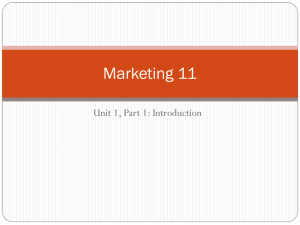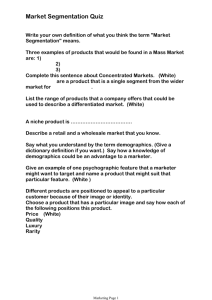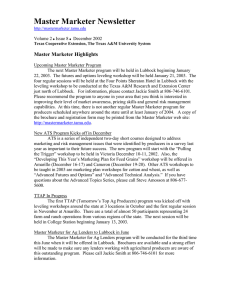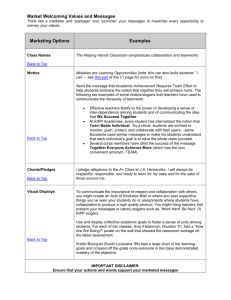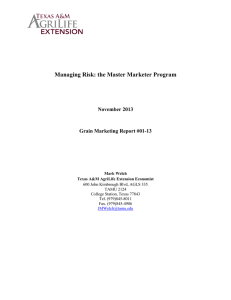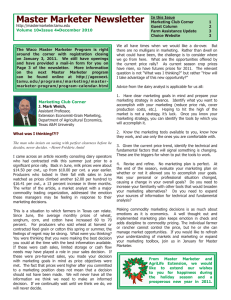Master Marketer Newsletter
advertisement
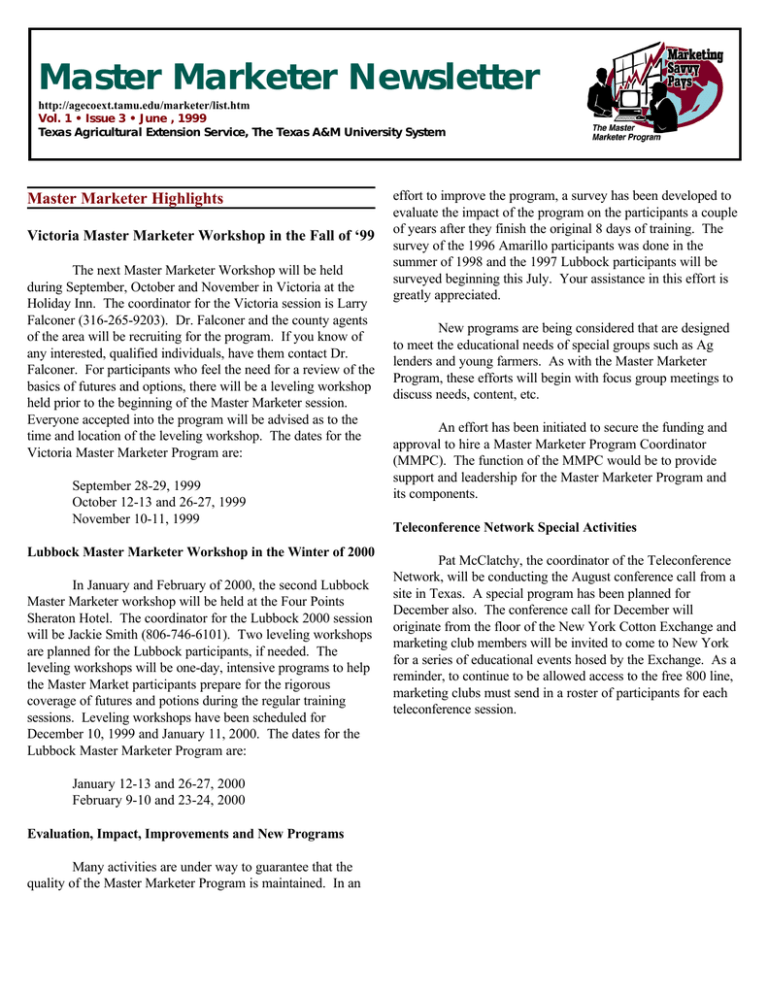
Master Marketer Newsletter http://agecoext.tamu.edu/marketer/list.htm Vol. 1 • Issue 3 • June , 1999 Texas Agricultural Extension Service, The Texas A&M University System Master Marketer Highlights Victoria Master Marketer Workshop in the Fall of ‘99 The next Master Marketer Workshop will be held during September, October and November in Victoria at the Holiday Inn. The coordinator for the Victoria session is Larry Falconer (316-265-9203). Dr. Falconer and the county agents of the area will be recruiting for the program. If you know of any interested, qualified individuals, have them contact Dr. Falconer. For participants who feel the need for a review of the basics of futures and options, there will be a leveling workshop held prior to the beginning of the Master Marketer session. Everyone accepted into the program will be advised as to the time and location of the leveling workshop. The dates for the Victoria Master Marketer Program are: September 28-29, 1999 October 12-13 and 26-27, 1999 November 10-11, 1999 Lubbock Master Marketer Workshop in the Winter of 2000 In January and February of 2000, the second Lubbock Master Marketer workshop will be held at the Four Points Sheraton Hotel. The coordinator for the Lubbock 2000 session will be Jackie Smith (806-746-6101). Two leveling workshops are planned for the Lubbock participants, if needed. The leveling workshops will be one-day, intensive programs to help the Master Market participants prepare for the rigorous coverage of futures and potions during the regular training sessions. Leveling workshops have been scheduled for December 10, 1999 and January 11, 2000. The dates for the Lubbock Master Marketer Program are: January 12-13 and 26-27, 2000 February 9-10 and 23-24, 2000 Evaluation, Impact, Improvements and New Programs Many activities are under way to guarantee that the quality of the Master Marketer Program is maintained. In an effort to improve the program, a survey has been developed to evaluate the impact of the program on the participants a couple of years after they finish the original 8 days of training. The survey of the 1996 Amarillo participants was done in the summer of 1998 and the 1997 Lubbock participants will be surveyed beginning this July. Your assistance in this effort is greatly appreciated. New programs are being considered that are designed to meet the educational needs of special groups such as Ag lenders and young farmers. As with the Master Marketer Program, these efforts will begin with focus group meetings to discuss needs, content, etc. An effort has been initiated to secure the funding and approval to hire a Master Marketer Program Coordinator (MMPC). The function of the MMPC would be to provide support and leadership for the Master Marketer Program and its components. Teleconference Network Special Activities Pat McClatchy, the coordinator of the Teleconference Network, will be conducting the August conference call from a site in Texas. A special program has been planned for December also. The conference call for December will originate from the floor of the New York Cotton Exchange and marketing club members will be invited to come to New York for a series of educational events hosed by the Exchange. As a reminder, to continue to be allowed access to the free 800 line, marketing clubs must send in a roster of participants for each teleconference session. Guest Column Melvin Brees, Farm Management Specialist University Extension #1 Courthouse Square Fayette, MO 65248 660-248-2272 This month’s guest article is by Melvin Brees, an Extension Farm Management Specialist from the University of Missouri System. The article is a reprint from the May 14, 1999 Decisive Marketing newsletter, a weekly newsletter published by University Extension, University of Missouri System, Lincoln University. While Melvin’s comments are specifically geared towards the soybean market, they are relevant for just about all the major crops produced in Texas (wheat, corn, grain sorghum, cotton, rice and soybeans). ‘99 Soybeans- What Strategy? Currently, soybean prices are the lowest they have been since 1976. If USDA’s Supply and Demand projections (issued on Wednesday) hold up, it’s going to get worse! The expected soybean acreage expansion results in another potential record crop of 2.88 billion bushels. Even with expectations of record demand in 1999-2000, ending stocks are expected to grow to a record 595 million bushels. These bearish numbers produce an expected average price of $4.35. That would be the lowest average price since 1971-72! This bearish outlook doesn’t offer much hope for improved soybean prices. In addition, continued wet weather and corn planting delays would only increase soybean acreage. The demand projections may also be optimistic when compared to this year. The resulting supplies are large enough that only significantly stronger demand or serious dry weather would have much positive impact on prices. In the face of all of this, what is the marketing strategy for soybeans? One strategy is to try to “make the best of a bad situation.” This strategy accepts the USDA expectations of large production, big carryover and lower price. If prices are going to get worse, then the idea is to take steps to avoid the lows at or below $4.35. While any summer price rallies will probably be very limited, they could be used to forward contract for fall delivery at prices in the upper four-dollar range. If prices decline, as expected, the LDP could be used in the fall to enhance the contracted price resulting in a net price received that is above the $5.26 nation loan price. Another strategy is to take the position that prices are bad, can’t get much worse, won’t stay low forever and will eventually have to improve. Soybean prices are below $5 but they haven’t spent much time below $5 since 1972. They were below $5 for about seven months in 1975, a few weeks in 1985 and for almost eight months in 1986. Currently they’ve been less that $5 for almost four months, so how much longer will they be this low? There is still a lot of time (more than a year) to sell new crop beans. Markets typically bottom when everyone is bearish and expects low prices to last forever-which describes the current situation. The market loan or LDP provides a price floor that is above current market prices and this limits the risk associated with waiting (hoping?) for a price recovery. This strategy uses the loan price as the floor and, if prices improve, waiting (probably storing) for better prices sometime in the year ahead. What are the risks? Price protection is limited to loan price and significant storage costs could accumulate before the beans are sold, resulting in a net price will below loan price. Which strategy do you use? History suggests that eventually prices will get better, but when? It is very possible that soybean prices will get worse before they ever get better and they may not get better anytime soon-likely a year or more. The market loan or LDP does help provide downside protection whichever strategy you choose. Along with price risk, your approach to marketing new crop soybeans may depend, as much as anything, upon how long you can afford to wait before you have to have the money. Market Competition Inside the Texas Agricultural Extension Service In the last couple of newsletter we asked how many of you would be interested in a simulated marketing activity where clubs could compete in marketing a farm’s crops. Based on the lack of responses that we got back from you, we are going to assume that it is of little interest. I guess this is one of those cases where something sounded like a good idea to us, but just was not of much interest to mist of you. We will use this section of the newsletter for something else in the future. While tax reports serve their purpose, they simply are not sufficient in helping producers identify business strengths and weaknesses, nor do they document the profitability of an ongoing business venture or its component enterprises. Farm and ranch managers need timely financial statement and analysis to support business decisions. However, they often lack the time and accounting expertise. Accountants and tax preparers can play an important rope in assisting producers to develop and improve a management information system. For those who are interested in some kind of simulated/paper trading activity beyond what you can already do yourself, the sites listed below may provide you the opportunities you are looking for. We put this list together without spending much time at each site so we cannot tell you too much about them. Most of the sites will have some kind of fee structure attached to simulated trading, but not all of them will. We cannot say that these are the only or the best sites, but they are a sample that gives you a place to start. If you look around on the Internet you will probably find others. To assist in bridging the gap between producers and accountants, a workshop entitled “Getting Beyond Tax Preparation” will be offered on August 17 and 18, 1999 at the Nobel Foundation in Ardmore, Oklahoma. This course is cosponsored by the Texas Agriculture Extension Service, the Oklahoma Cooperative Extension Service, the Samuel Roberts Nobel Foundation, and the Texas and Oklahoma Societies of Certified Public Accountants. Chicago Mercantile Exchange- Trade CME futures through Auditrack. http://www.cme.com/market/auditrack/intro.html Chicago Board of Trade- Trade CBOT futures through Auditrack http://www.cbot.com/ourproducts/dow/indmock.htm Kansas City Board of Trade- Trade KCBOT futures through Auditrack http://kcby.donney.net/ MidAm Exchange- Trade MidAm futures through Auditrack http://www.midam.com/paper.htm Auditrack http://auditrack.com/ Investor Links- provide links to about 15 sites that provide some type of simulated trading http://www.investorlinks.com/comm-sim.html Trade Comp http://www.tradecomp.com/SimTrade.html This course will focus on farm and ranch managerial accounting. Producers and the professionals they hire will learn accounting principles and how to communicate information to reach business goals. Accountants will earn 16 hours of CPE credits. Interested person can contact Dr. Jim McGrann at (409) 845-1861, Dr. Damona Doye at (405)7449813, or Dr. Mike Hardin at (405)744-9815. Texas Risk Management Education Program Update Risk Management economists have had the opportunity to analyze a wide-range of farm types and enterprises using FARM Assistance including corn, cotton, sorghum, wheat, rice, dairy, cow-calf, stockers, feedlot cattle, crawfish and timber, just to name a few. The FARM Assistance subscription fee includes the analysis of two alternative management strategies- versus how the farm/ranch is currently operating. The economic impact of several different alternative management strategies has been analyzed thus far. A few of these strategies are: Ž adding Sim-U-Trade http://www.paragoninvestments.com/Simutrade.htm World Link Futures http://www.worldlinkfutures.com/ additional acreage(both lease and purchase) replacement and expansion Ž having dairy replacement heifers custom raise rather than raised on the farm Ž farm liquidation Ž shifting out of crop production, increase cow herd size Ž integrating a stocker enterprise Ž crop insurance alternatives Ž change from flood to pivot irrigation Ž machinery One of the more common strategies requested by producers thus far has been leasing of purchasing additional land. Another common question is simply: can I survive the way I am operating now? If you would like to know more about the FARM Assistance program, please call our toll free number:1-877TAMRISK. The Choice Web Site http://www.farmsource.com Farmsource.com is run by the Monsanto Company. As you might guess, this site provides an abundance of information regarding Monsanto products, including on-line training courses for learning about concepts and principles associated with biotechnology, commercial plant seed development, and other related topics. Farmcourse.com is also a good source for agricultural news and finding other agricultural information using the site’s categorized list of links to other agriculture related sites. New to this site is the “Farmers Market”, a classified ads section containing farm equipment, buildings, vehicles, livestock, boats, antiques, and help wanted, just to name a few. One of the more unique features of Farmsource.com is the ability to customize the site’s main page to display user specified weather information, cash prices for specified locations, and futures prices. Prepared By: Dean McCorkle Extension Economist - Risk Management Dean McCorkle Texas Agricultural Extension Service Department of Agricultural Economics Texas A&M University College Station, Texas 77843-2124 (409) 845-9589
